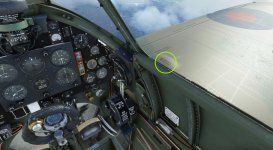bazzar
Charter Member 2018
The gauge debate
As we edge closer to release, we are getting a lot of differing comment over the cockpit finish. In particular, a lot of people are surprised to see new-looking gauges etc.
I would just like to point out some logic here.
If an aircraft in the Battle of Britain, was say, a month or two old, then why would it have aged gauges? Why would the instrument markings be brownish stained or faded? Why would the cockpit be incredibly scratched EVERYWHERE?
Some of these aircraft were delivered fresh from the factory with the paint barely dry and were lucky to get through one day of battle before being destroyed, sadly, along with their pilot.
Anybody who still doubts whether I am correct or not should take a look at this original film of a Spitfire "Daily Inspection"from 1940. It is of a 19 Squadron Mk1. Pay special attention to the close-ups of the ground chappie adjusting thew gauges. Any signs of wear, scratches, paint-fade?
Brownish stains and decay only appears on aircraft that have had many years of service and are not restored. Instruments, in particular, spend their lives behind glass, with a bezel sealed by a rubber O ring. It takes a long time for an instrument to decay.
We wish to portray the Mk1A as it would have appeared during the Battle of Britain.
Anyone who wants a Spitfire to look like like it is 70 years old with the relative ageing, is welcome to repaint the model the way they wish. We will be releasing authentic finishes.
As we edge closer to release, we are getting a lot of differing comment over the cockpit finish. In particular, a lot of people are surprised to see new-looking gauges etc.
I would just like to point out some logic here.
If an aircraft in the Battle of Britain, was say, a month or two old, then why would it have aged gauges? Why would the instrument markings be brownish stained or faded? Why would the cockpit be incredibly scratched EVERYWHERE?
Some of these aircraft were delivered fresh from the factory with the paint barely dry and were lucky to get through one day of battle before being destroyed, sadly, along with their pilot.
Anybody who still doubts whether I am correct or not should take a look at this original film of a Spitfire "Daily Inspection"from 1940. It is of a 19 Squadron Mk1. Pay special attention to the close-ups of the ground chappie adjusting thew gauges. Any signs of wear, scratches, paint-fade?
Brownish stains and decay only appears on aircraft that have had many years of service and are not restored. Instruments, in particular, spend their lives behind glass, with a bezel sealed by a rubber O ring. It takes a long time for an instrument to decay.
We wish to portray the Mk1A as it would have appeared during the Battle of Britain.
Anyone who wants a Spitfire to look like like it is 70 years old with the relative ageing, is welcome to repaint the model the way they wish. We will be releasing authentic finishes.




-squadron-at-horne,-yorkshire,-england.-rcaf.jpg;w=630)














